Lewis Carroll and Chess - an Introduction
By Roger Scowen
Lewis Carroll’s association with chess rests largely on the theme of Through the Looking-Glass: Alice’s journey as a pawn across
the chessboard eventually to become a Queen. However, his diaries, library and photographs reveal a wider interest in the game. This facility explores these connections.
Click on “The Game” (above) to explore the moves in the game in Through the Looking-Glass.
Through the Looking-Glass
The thirty-two pieces of a chess set are identified as ‘Dramatis Personae’ at the start of the book, and each of them has some part in the story, although ‘Lily’ is replaced by Alice as ‘Lily’s too young to play’. The wasp in the deleted ‘Wasp in a wig’ chapter is not one of the chess pieces in the ‘Dramatis Personae’. Did Lewis Carroll change this table after deleting the wasp chapter, or construct the table after the story had been typeset?
The story’s link with chess is faulty in many ways, but these can be excused because as Alice Hargreaves (neé Liddell) herself later wrote (A Hargreaves, 1932):
Much of Through the Looking-Glass is made up of them [i.e. ‘stories told before the famous trip up the river to Godstow’], particularly the ones to do with chessmen, which are dated by the period when we were excitedly learning chess.
Thus Lewis Carroll was introducing Alice and her sisters to chess pieces and what they are for, for example, how a pawn can move two squares on its first move, but then one square at a time, and when it reaches the eighth rank, it is promoted to another piece (usually a queen). It is then not unnatural to treat them as real and this, for example, explains why the White Knight has such poor balance – a chess piece that is a knight is not designed to slide down pokers, or ride on a toy horse.
Colours
In chess, the two sides are always known as Black and White regardless of the colour of the physical pieces, but Lewis Carroll refers to Red and White, the usual colours of an ivory or bone chess set.
Diagram
Despite Lewis Carroll’s concern for the quality of his books, the chess diagram and moves are not well printed, and the pieces standing on black squares are particularly difficult to distinguish. In the first reprint, 12th thousand, some of the page numbers corresponding to the moves have become faint. And in the 25th thousand (1872), the white kings disappeared from the diagram without Lewis Carroll or anyone else noticing. Lewis Carroll finally pointed out the omission in August 1878 (the 42nd thousand). In the revised 1897 edition, which retained the same pagination as the original 1872 publication, the chess diagram page was taken from the 1887 People's Edition which referred to entirely different page numbers.
Pieces
John Tenniel’s illustrations are based on pieces of the design known as St George’s pattern, not the Staunton pattern.
The Moves and the 1887 Preface
Eventually, Lewis Carroll added a preface admitting that the ‘alternation of Red and White is perhaps not so strictly observed as it might be’ when he might more precisely have confessed the ‘alternation of Red and White is not observed’.
These and other deviations from the laws of chess later pained some pedantic chess players, and in 1910, Donald M. Liddell (unrelated to Alice) constructed a genuine chess game that followed the story (British Chess Magazine, Vol 30, p181-184). The chess editor of Bradford Observer Budget was unimpressed, see British Chess Magazine (Vol 30, p256-257).
Lewis Carroll as Chess Player
The diaries mention some occasions when Lewis Carroll played games of chess; for example, he beat Tennyson’s sons very easily, and he played in the train during his journey to Russia (see below). However no games of his appear to have ever been recorded. Nor did he ever play in any tournament.
Enid Shawyer (née Stevens) wrote (see Cohen, 1989, p123):
Chess was the most fun [of the board games she played as a child with Lewis Carroll]. He was, of course, a master of the game, but when he played with a child the knights and bishops became alive and held heated discussions over the rights of queens or the ownership of castles.
And she also wrote (see Cohen, 1989, p128):
We had lovely games. He had backgammon and chess and all the possible things you can think of; but he didn’t play them as one had been taught to play them, he had his own rules. Chess was the greatest fun. We were made to play properly in chess, he was a master of this game - he couldn’t bear to do anything else; but for all the other games he had entirely new rules.
Mike Fox & Richard James (1987) claim that Lewis Carroll solved chess problems as a cure for insomnia, but this might be based on mistaken reading of Pillow Problems.
References to Chess in Carroll’s Letters
In a letter dated 19 April 1862, to Mary, his sister, Lewis Carroll writes:
... Also I made a bargain with Lionel, that he was to give me some MS of his verses, and I was to send him some of mine. It was a very difficult bargain to make. I almost despaired of it at first, he put in so many conditions. 1st I was to play a game of chess with him - this with much difficulty was reduced to ‘12 moves on each side.’ but this made little difference as I check-mated him at the 6th move. ...
Lionel Tennyson was born in 1854.
References to Chess in Carroll’s Diaries
Here are the complete references to chess in the surviving volumes of Lewis Carroll’s private journal; volume and page numbers refer to the Lewis Carroll Society’s publication of The Diaries of Lewis Carroll, edited and annotated by Edward Wakeling.
10 August 1866 [Vol 5, p172]
Spent a good deal of the day watching the “Chess Tourney”.
[See Books in Carroll's Library and Chess in Carroll's photographs below]
3 September 1866 [Vol 5, p173]
Received from Vincent 250 copies of the blank registers for chess games - chess is the family occupation at present, consultation-games are most interesting, far better than the ordinary single game, and the taking down the game, so that it can be played over again, adds very much to the interest.
[No recorded games of Lewis Carroll have been located. On 29 December 1866, there is a debit in Lewis Carroll’s bank account for £6-14-0 to Joseph Vincent, printers and stationers of High Street, Oxford.]
24 December 1866 [Vol 5, p189]
Left Oxford by the 8.25 for Birmingham, and so home by Derby and York. We had to wait an hour at Normanton, when I brought out my in statu quo chess-board, and had a game with one of my travelling companions.
26-27 July 1867 [Vol 5, p283]
[The diary entry describes the journey from Königsberg.]
The other gentleman we found to be an Englishman, who had lived in Petersburg for 15 years, and was returning from a visit to Paris and London. ... He proved a very pleasant addition to our party, and he and I had three games of chess in the course of the second day, which it is perhaps as well that I did not record, as they all ended in my defeat.
[The opponent may have been Andrew Muir, described on 31 July 1867 (Vol 5, p293) as ‘Our fellow-traveller’.]
26 August 1867 [Vol 5, p349]
[The diary entry describes the journey from St Petersburg to Warsaw.]
At 2 we entered the train for our weary journey to Warsaw, and found ourselves in the same carriage, though not the same compartment, with the Hunts, who were on their way to Berlin, so that our routes were the same to Wilna, which we reached 6 p.m. During the evening we visited each other, and my travelling chess-board proved of service.
[The opponent was R.M. Hunt, from New York (Vol 5, p336).]
He continued his diaries for another 30 years but there are no further references to chess.
Books in Carroll’s Library
At his death, Lewis Carroll possessed thousands of books. His library was auctioned on 11 May 1898, four months after his death. Various books were resold later by booksellers. The various catalogues have been reprinted in Lewis Carroll Bibliophile, edited by Jeffrey Stern, published by The Lewis Carroll Society, 1997. A comprehensive catalogue of the
library in available in Lewis Carroll Among His Books by Charlie Lovett, published by McFarland, 2005.
Lot 895 (bought for 12 shillings) of the auction was described:
Walker on Chess, Staunton’s Chess Players’ Companion, Staunton’s Chess Tournament, Strutt’s Sports and Pastimes, and 2 others.
In June 1898, Blackwell’s catalogue included a book initialled by Lewis Carroll:
1004 Chess Strategy. A Collection of the most beautiful Chess Problems composed by J.B., illustrated by diagrams and accompanied by Solutions, 8vo, cloth 2/6.
In 1898, The Art and Antique Agency, (High Street, Oxford), Catalogue Number 2, included:
223 Chess - THE KNIGHT'S TOUR, in a continuous Ride over 48 Boards or 3072 Squares, Adapted from Bryon's Mzeppa, by A ESCHWEGE, 8vo, stiff cloth cover with gold knight piece, 6s. 1896
Interesting in itself, but doubly so by the interesting author's inscription to Lewis Carroll.
The following sections give further details of these books.
Walker on Chess
It is impossible to identify this book. George Walker (1803-1879) wrote many books on chess, including a bibliography of books on chess (1838), an edition of Philidor (1832), a treatise (four editions, 1832-1846), an elementary guide (three editions, 1835-1846), a translation of Jaenisch’s book (1847), collections of games (1835, 1844 and 1893), a collection of stories and reminiscences (1850). Other possibilities include: (1) W G Walker - A selection of games at chess, actually played in London, by the late Alexander M’Donnell (1836), (2) J Walker - Modus operandi; or, the automaton chess-player (1866) or (3) J M Walker - The history of Oxford University Chess Club (1885).
The third, but not the second (1833), edition of George Walker's treatise:
Walker, George, A new treatise on chess, London: Sherwood, Gildert & Piper, 3rd edition, 1841, xvi+296p.
has 'Walker on chess' on the spine and as the header of most pages. It seems the most likely book that was being sold. If so, Lewis Carroll may well have been given it as a boy.
On the other hand, the first-mentioned item in a lot to be sold at auction is often the most valuable, and this suggests that the book was:
Walker, George (compiler), Chess studies: comprising one thousand games, actually played during the last half century; presenting a unique collection of classical and brilliant specimens of chess skill, in every stage of the game: and thus forming a complete encyclopedia of reference, London: Longman, Brown, Green, and Longmans, 1844, xx+172p.
or the reprint:
Walker, George (compiler), Chess studies: comprising one thousand games, a collection of classical and brilliant specimens of chess skill. New edition, with introduction by E. Freeborough, London: Kegan Paul, Trench, Trübner, 1893, xvi+172p.
The cover and spine of the reprint have Walker’s chess studies. The similarity with the auctioneer’s description coupled with the fact that it was the only one of Walker’s books worth reprinting after forty years suggests this may be the book being sold. It is still valuable for reference.
Staunton’s Chess Players’ Companion
Howard Staunton (1810-1874) dominated British chess as a player, journalist, author, and organizer in the middle of the nineteenth century. His book, The chess-player’s handbook, became the standard introduction to the game. First published in 1847, it was reprinted and revised right up to 1942. Chess pieces, designed by Nathaniel Cooke in 1835, endorsed by Staunton and patented in 1849, have become the world-wide normal pattern. This book was:
Staunton, Howard. The chess-player’s companion; comprising a new treatise on odds, and a collection of games contested by the author with various distinguished players during the last ten years; including the great French match with Mons. St. Amant; to which are added a selection of new and instructive problems, London: Henry G Bohn, 1849, xii+510p.
Carroll’s copy might have been one of the reprints dated 1861, 1870, 1875, 1877, 1879, 1882, 1884, 1887, or 1889.
Staunton’s Chess Tournament
In 1851, inspired by the Great Exhibition to be held in London, Howard Staunton ‘conceived the astonishing and original idea of holding a tournament at which all the best players in Europe would be assembled’ (Harry Golombek). After the tournament was over, Staunton wrote this book about the tournament:
Staunton, Howard. The chess tournament, a collection of the games played at this celebrated assemblage, illustrated by copious diagrams, and notes, critical and explanatory, London: Henry G Bohn, 1852, xcii+377p.
This was reprinted in 1873, but became a very scarce book until a facsimile was published in 1986.
Hon H.T. Liddell, Dean Liddell’s cousin (his father’s eldest brother’s eldest son) was a member of the organizing committee and a subscriber (five pounds). C.E. Ranken, brother of Lewis Carroll’s friend W.H. Ranken, was runner-up in the subsidiary ‘Provincial’ tournament for British players living outside London.
Strutt’s Sports and Pastimes
Joseph Strutt, The sports and pastimes of the people of England including the rural and domestic recreations, May games, mummeries, shows, processions, pageants, and pompous spectacles, from the earliest period to the present time, (New edition with a copious index by William Hone), London: Thomas Tegg, 1831.
This book is only incidentally concerned with chess. Lewis Carroll may have owned one of the earlier editions published in 1801 or 1810 .
Chess Strategy
J.B. [John Brown], Chess strategy: a collection of the most beautiful chess problems, composed by ‘J. B. of Bridport’. and contributed by him to the chief chess periodicals during the last fifteen years; illustrated by diagrams and accompanied by solutions, London: N Trübner, 1865, vii+118p.
This is a posthumous work of the problemist John Brown (1827-1863) published by his friends in an attempt to raise funds for his widow. H Weenink (1926) describes his style:
His influence was very great in keeping before the problemists of the day the charms of sober and graceful construction and in preventing these from being completely lost in the whirlpool of wild thematic fantasies.
An online edition of this book (prepared by Anders Thulin, Malmö, Sweden, in 2007) is available here:
http://www.anders.thulin.name/PDF/JB_of_Bridport_Chess_Strategy.pdf
Lewis Carroll may have bought his copy as an act of charity at the Redcar tournament where John Brown’s fellow problemists were competing.
Chess - Knight's Tour
H Eschwege, Chess - The Knight's tour in a continuous and uninterrupted ride over 48 boards or 3072 squares; adapted from Byron's 'Mazeppa' by H Eschwege, Shanklin Isle of Wight: Silsbury Bros. 1896, [36]p, diag, 22cm, limp.
Douglas A Betts describes this book (in his bibliography of chess, 1850-1968):
28 diagrams are shown and each 'move' of the knight corresponds with a word from the poem ‘Mazeppa’, the words being entered in the squares. The tour is the same on each board and to read the poem one must follow the knight's tour. The number of words corresponds with the 3072 squares.
In 1879, Lewis Carroll had befriended Kathleen Eschwege, the author's daughter, while on a railway journey, and subsequently kept an intermittent contact with the family.
Chess in Carroll’s Photographs
The following photographs, by Carroll or within his photographic albums feature chess being played. Each photograph is identified by its Image number as listed in
Edward Wakeling’s The Photographs of Lewis Carroll - A Catalogue Raisonné, published by Princeton University Press, 2015.
In all the photos, the pieces are of the design known as St George’s pattern rather than the now universal Staunton pattern which was modern at the time.
440 The Misses Lutwidge, Summer 1859
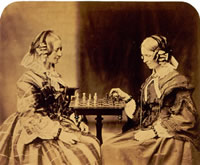 Margaret and Henrietta Lutwidge, Carroll’s maternal aunts are pictured playing chess. The image is reproduced in (NMPFT, p26)
Margaret and Henrietta Lutwidge, Carroll’s maternal aunts are pictured playing chess. The image is reproduced in (NMPFT, p26)
The position appears to be (in Forsyth Edwards notation): 4k3/3q3r/r4p2/7p/1B2N3/P6P1/2Q5/4K2R with Black in the act of completing the move Qd7.
Click Here to show position on chessboard.
The board is bigger than the table top.
Click here to see the reference to this image in Science and Society picture library.
442 Smith Sisters, Summer 1859
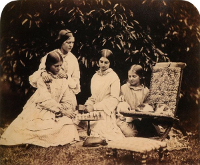 Fanny, Maria, Joanna, and Anne Smith are pictured playing chess in the garden of Dinsdale Rectory, Yorkshire. A cat lies sleeping on a chair. This photo is in the Princeton collection (Album A(I):43). It is reproduced in (Taylor, p145) and (Cohen, p98). The position appears to be from a genuine game, althought sisters seem to have been posed for the purposes of a photographic composition rather than caught in the act of playing chess; Fanny could play the white pieces, but none of the other three sisters could conveniently play Black. There is no evidence of concentrated thought, more of a harmless pastime to while away the hours after lunch. The board is bigger than the table top, so it would be necessary to give any captured pieces to Joanna, who is holding the box for the pieces, or drop them on to the grass.
Fanny, Maria, Joanna, and Anne Smith are pictured playing chess in the garden of Dinsdale Rectory, Yorkshire. A cat lies sleeping on a chair. This photo is in the Princeton collection (Album A(I):43). It is reproduced in (Taylor, p145) and (Cohen, p98). The position appears to be from a genuine game, althought sisters seem to have been posed for the purposes of a photographic composition rather than caught in the act of playing chess; Fanny could play the white pieces, but none of the other three sisters could conveniently play Black. There is no evidence of concentrated thought, more of a harmless pastime to while away the hours after lunch. The board is bigger than the table top, so it would be necessary to give any captured pieces to Joanna, who is holding the box for the pieces, or drop them on to the grass.
Click here to see the reference to this image in Harry Ransom Center, University of Texas.
1133 Rossetti Family, 7 October 1863
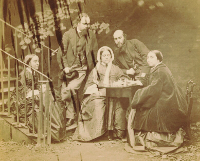 Members of the Rossetti family posing around a chess games in the garden of 12 Cheyne Walk, Chelsea.
Members of the Rossetti family posing around a chess games in the garden of 12 Cheyne Walk, Chelsea.
The chess board is inlaid into the table, and has room at the side for drinks and captured pieces.
Christina Rossetti later wrote to Dodgson asking for twelve prints of this photo (quoted by Green, 1953, pages 204-5.)
Click here to see the reference to this image in the National Portrait Gallery Collection.
1134 Rossetti Family, 7 October 1863
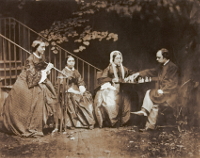 Dante Gabriel Rossetti is seen playing chess in the garden of 12 Cheyne Walk, Chelsea with his mother Frances while his two sisters look on. This photo is reproduced in (Cohen, p12).
Dante Gabriel Rossetti is seen playing chess in the garden of 12 Cheyne Walk, Chelsea with his mother Frances while his two sisters look on. This photo is reproduced in (Cohen, p12).
The chess board is inlaid into the table, and has room at the side for drinks and captured pieces. It is somewhat odd that Rossetti holds his hat in his left hand while moving a piece with his right.
Christina Rossetti later wrote to Dodgson asking for three prints of this photo (quoted by Green, 1953, pages 204-5.)
Click here to see the reference to this image in the National Portrait Gallery Collection.
Chess-Players, August 1866
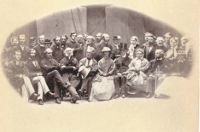 This photograph, in Album P(3) of the Morris L. Parrish collection in Princeton University, was kept by Lewis Carroll but probably not taken by him. Almost certainly it shows thirty of the contestants and guests at the Redcar chess congress that Lewis Carroll attended on 10 August 1866. Most have not been identified, but Cecil de Vere, the winner of the main tournament, is pictured (the tall young man left of centre standing with his arms folded). To his left in front, seated holding his top hat is Howard Staunton. Two chess problemists, Walter Grimshaw (in the centre at the back, just to the right of Howard Staunton) and Henry E. Kidson (standing to the left and behind the seated gentleman with a stick on the right) are also probably identifiable.
This photograph is reproduced in (Taylor, p205).
This photograph, in Album P(3) of the Morris L. Parrish collection in Princeton University, was kept by Lewis Carroll but probably not taken by him. Almost certainly it shows thirty of the contestants and guests at the Redcar chess congress that Lewis Carroll attended on 10 August 1866. Most have not been identified, but Cecil de Vere, the winner of the main tournament, is pictured (the tall young man left of centre standing with his arms folded). To his left in front, seated holding his top hat is Howard Staunton. Two chess problemists, Walter Grimshaw (in the centre at the back, just to the right of Howard Staunton) and Henry E. Kidson (standing to the left and behind the seated gentleman with a stick on the right) are also probably identifiable.
This photograph is reproduced in (Taylor, p205).
Chess Variants and Chess Sets and Other Resources
Chess Variants
One minor branch of chess is devoted to games which are variants of chess, for example, they may be played on different-sized boards, or change the moves of the pieces. Lewis Carroll invented new variants of backgammon and croquet, but not as far as is known, variants of chess. The Alice books have inspired some variants invented by Vernon Parton, including Alice chess (played on two boards – after every move, the piece played is transferred to the other board), Cheshire Cat chess (every time a square is vacated it disappears although pieces may subsequently pass over it to move).
Lewis Carroll and Chess Sets
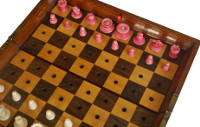 Dodgson owned one of the high quality In Statu Quo travelling chess sets, sold by John Jaques under that brand name. Dodgson did not invent this set although
some biographers have stated that he did. For example Morton Cohen (1995, p286) writes: “He invented his ‘in statu quo’ chess board for use in travelling”.
Dodgson owned one of the high quality In Statu Quo travelling chess sets, sold by John Jaques under that brand name. Dodgson did not invent this set although
some biographers have stated that he did. For example Morton Cohen (1995, p286) writes: “He invented his ‘in statu quo’ chess board for use in travelling”.
Cohen cites a passage in the diaries (Monday 24 December 1866): “Left Oxford by the 8.25 for Birmingham, and so home by Derby and York. We had to wait an hour at Normanton, when I brought out my in statu quo chess-board, and had a game with one of my travelling companions.”
Other writers make a similar claim but with no evidence, for example, Martin Gardner (1960, p296): “Carroll’s inventions include a chess set for travelers, with holes to hold pegged pieces”
and John Fisher (1973, p12): “Carroll’s own inventions included the prototype of the miniature travelling chess set with holes to prevent the pegged pieces from tumbling over ....”
The Alice books have inspired many artistic and decorative chess sets where the pieces are small figurines rather than the conventional shapes.
Alice and the Chess Master
An interesting theory has been developed around the idea that the actual moves in the chess game in Through the Looking-Glass represent stages in the relationship between Lewis Carroll, Alice and Mrs Liddell.
For further information about this theory visit:
http://www.echecs-histoire-litterature.com
References
Cohen, Morton N. Lewis Carroll - Interviews & recollections, 1989.
Cohen, Morton N. Reflections in a looking glass - A centennial celebration of Lewis Carroll, photographer, 1998.
Hargreaves, Alice (Liddell). Alice’s recollections of Carrollian days, as told to her son, Cornhill Magazine, July 1932, 1-12. (reprinted in Cohen, 1989, p83-88).
Stern, Jeffery (editor). Lewis Carroll bibliophile, 1997.
NMPFT (National Museum of photography film and television). Lewis Carroll photographer, 1987.
Taylor, Roger, and Wakeling, Edward. Lewis Carroll photographer: The Princeton University Library albums, 2002.
Wakeling, Edward (editor). Lewis Carroll’s diaries; The private journals of Charles Lutwidge Dodgson (Lewis Carroll), 10 volumes, 1993-2008.
Weenink, H. (edited by George Hume and Alain C White). The chess problem, 1926.
Further Reading
Glen Robert Downey
'The Truth about pawn promotion: the development of the chess motif in Victorian fiction'
University of Victoria, Canada Website
A. S. M. Dickens
Alice in Fairyland
Privately printed, 1976
Reprinted from Jabberwocky, Winter 1976
 Margaret and Henrietta Lutwidge, Carroll’s maternal aunts are pictured playing chess. The image is reproduced in (NMPFT, p26)
Margaret and Henrietta Lutwidge, Carroll’s maternal aunts are pictured playing chess. The image is reproduced in (NMPFT, p26) Fanny, Maria, Joanna, and Anne Smith are pictured playing chess in the garden of Dinsdale Rectory, Yorkshire. A cat lies sleeping on a chair. This photo is in the Princeton collection (Album A(I):43). It is reproduced in (Taylor, p145) and (Cohen, p98). The position appears to be from a genuine game, althought sisters seem to have been posed for the purposes of a photographic composition rather than caught in the act of playing chess; Fanny could play the white pieces, but none of the other three sisters could conveniently play Black. There is no evidence of concentrated thought, more of a harmless pastime to while away the hours after lunch. The board is bigger than the table top, so it would be necessary to give any captured pieces to Joanna, who is holding the box for the pieces, or drop them on to the grass.
Fanny, Maria, Joanna, and Anne Smith are pictured playing chess in the garden of Dinsdale Rectory, Yorkshire. A cat lies sleeping on a chair. This photo is in the Princeton collection (Album A(I):43). It is reproduced in (Taylor, p145) and (Cohen, p98). The position appears to be from a genuine game, althought sisters seem to have been posed for the purposes of a photographic composition rather than caught in the act of playing chess; Fanny could play the white pieces, but none of the other three sisters could conveniently play Black. There is no evidence of concentrated thought, more of a harmless pastime to while away the hours after lunch. The board is bigger than the table top, so it would be necessary to give any captured pieces to Joanna, who is holding the box for the pieces, or drop them on to the grass. Members of the Rossetti family posing around a chess games in the garden of 12 Cheyne Walk, Chelsea.
Members of the Rossetti family posing around a chess games in the garden of 12 Cheyne Walk, Chelsea. Dante Gabriel Rossetti is seen playing chess in the garden of 12 Cheyne Walk, Chelsea with his mother Frances while his two sisters look on. This photo is reproduced in (Cohen, p12).
Dante Gabriel Rossetti is seen playing chess in the garden of 12 Cheyne Walk, Chelsea with his mother Frances while his two sisters look on. This photo is reproduced in (Cohen, p12). This photograph, in Album P(3) of the Morris L. Parrish collection in Princeton University, was kept by Lewis Carroll but probably not taken by him. Almost certainly it shows thirty of the contestants and guests at the Redcar chess congress that Lewis Carroll attended on 10 August 1866. Most have not been identified, but Cecil de Vere, the winner of the main tournament, is pictured (the tall young man left of centre standing with his arms folded). To his left in front, seated holding his top hat is Howard Staunton. Two chess problemists, Walter Grimshaw (in the centre at the back, just to the right of Howard Staunton) and Henry E. Kidson (standing to the left and behind the seated gentleman with a stick on the right) are also probably identifiable.
This photograph is reproduced in (Taylor, p205).
This photograph, in Album P(3) of the Morris L. Parrish collection in Princeton University, was kept by Lewis Carroll but probably not taken by him. Almost certainly it shows thirty of the contestants and guests at the Redcar chess congress that Lewis Carroll attended on 10 August 1866. Most have not been identified, but Cecil de Vere, the winner of the main tournament, is pictured (the tall young man left of centre standing with his arms folded). To his left in front, seated holding his top hat is Howard Staunton. Two chess problemists, Walter Grimshaw (in the centre at the back, just to the right of Howard Staunton) and Henry E. Kidson (standing to the left and behind the seated gentleman with a stick on the right) are also probably identifiable.
This photograph is reproduced in (Taylor, p205). Dodgson owned one of the high quality In Statu Quo travelling chess sets, sold by John Jaques under that brand name. Dodgson did not invent this set although
some biographers have stated that he did. For example Morton Cohen (1995, p286) writes: “He invented his ‘in statu quo’ chess board for use in travelling”.
Dodgson owned one of the high quality In Statu Quo travelling chess sets, sold by John Jaques under that brand name. Dodgson did not invent this set although
some biographers have stated that he did. For example Morton Cohen (1995, p286) writes: “He invented his ‘in statu quo’ chess board for use in travelling”.